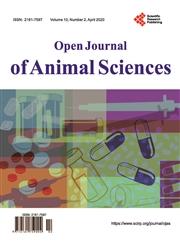Factors Associated with Increased Walleye Production in Lined Compared to Earthen-Substrate Ponds
引用次数: 2
Abstract
Walleye (Sander vitreus) fingerling production can be enhanced when the pond substrate is altered from earthen soils to an exposed liner; however, few differences in water chemistry, prey densities, and food habits have been identified that could potentially explain this production difference. Lack of an explanation led to further comparison of walleye fingerling culture between substrate types during 2016. Two ponds of each type were stocked with 1- to 3-day-old walleye fry, but lined ponds received an additional 104,166 fry/ha and were stocked 1 or 2 days later than earthen ponds (May 10). Walleyes in lined ponds achieved a growth advantage on May 31 (+2.5 mm) and on June 6 (+3.3 mm), but lengths were not significantly different at harvest (June 15). Lined ponds increased walleye yield and number 1.8-fold while not reducing individual fish size at harvest compared to earthen ponds. Walleye food habits were generally similar between pond types with a greater number of zooplankton being consumed through June 6 followed by an increase in larval chironomid consumption at harvest (June 15). After May 30, lined ponds exhibited lower dissolved oxygen and higher ammonia-nitrogen concentrations even though earthen ponds received additional (157 kg/ha) alfalfa (Medicago sativa) meal fertilizer. Also, at this time pH declined abruptly and remained below 8.2 in lined ponds. Moreover, the enhanced production in lined ponds coincided with walleyes that exhibited an increased pelagic (δ13C) signature during the culture period (2‰ to 3.3‰ more negative). Efforts to improve production in earthen-substrate ponds should focus on increasing the pelagic signature of the food web through fertilization strategies which increase ammonia-nitrogen (≈0.3 mg/L) and decrease dissolved oxygen (≈6.5 mg/L) while maintaining a pH between 8.0 and 8.2 during the second half of the rearing interval.与泥土基质池相比,衬砌池中Walleye产量增加的相关因素
当池塘基质从泥土变为裸露的衬垫时,Walleye(Sander vitreus)鱼种的产量可以提高;然而,在水化学、猎物密度和食物习惯方面几乎没有发现可以解释这种生产差异的差异。由于缺乏解释,2016年期间对不同基质类型的walleye鱼种培养进行了进一步比较。每种类型的两个池塘都放养了1到3天大的walleye鱼苗,但有内衬的池塘每公顷额外放养104166只鱼苗,比土池塘晚了1到2天(5月10日)。在5月31日(+2.5毫米)和6月6日(+3.3毫米),有内衬的池塘中的Walleyes获得了生长优势,但在收获时(6月15日),长度没有显著差异。与土制池塘相比,有内衬的池塘使大眼鱼的产量和数量增加了1.8倍,但在收获时并没有减少个体鱼的大小。Walleye的食物习惯在不同的池塘类型之间通常是相似的,直到6月6日,消耗了更多的浮游动物,随后在收获时(6月15日),幼虫的摇蚊消耗量增加。5月30日之后,尽管土制池塘增加了157公斤/公顷的苜蓿(Medicago sativa)粉肥,但有内衬的池塘表现出较低的溶解氧和较高的氨氮浓度。此外,此时pH值突然下降,并在有内衬的池塘中保持在8.2以下。此外,在有内衬的池塘中,产量的提高与walleyes相吻合,walleyes在培养期间表现出增加的远洋(δ13C)特征(负向增加2‰至3.3‰)。提高土底塘产量的努力应侧重于通过施肥策略增加食物网的上层特征,施肥策略增加氨氮(≈0.3 mg/L)和溶解氧(≈6.5 mg/L),同时在饲养间隔的后半段将pH值保持在8.0至8.2之间。
本文章由计算机程序翻译,如有差异,请以英文原文为准。
求助全文
约1分钟内获得全文
求助全文

 求助内容:
求助内容: 应助结果提醒方式:
应助结果提醒方式:


